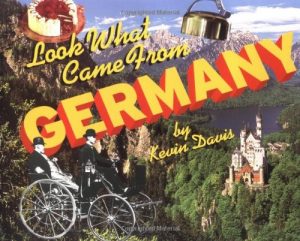The creators of FAIRYTALE NEWS mix up favorite tales in a comical quest with a pull-out treasure map.Little Jack Hubbard can’t wait to set sail with Cap’n Horatio Hubbard on a hunt for long-lost treasure. But the ship’s wolfish crew are suspiciously big and bad, and soon Jack is diving into the waves to rescue a valuable treasure map. All seems lost until Jack is saved by the Owl and the Pussycat (in a beautiful pea-green boat) and passes a witch’s gingerbread cottage, where two kids are caught in a culinary plot. . . . With the help of a handy removable map, readers will happily follow Jack’s path to the treasure through a fractured-fairytale land.
Primary (ages 6-9)
Material appropriate for primary age groups
Brothers
Whether the rivalry is about territory, possessions, the biggest, or the most, anyone with a sibling will relate to the ongoing competition between these two canines. Taken to ridiculous heights, this series of situations with surprisingly human overtones illustrates their ongoing struggle to get along. It’s a rivalry that knows no bounds. Julius the Elder describes how he dominates, tricks, subdues, and, yes, even admires his exuberant young pup of a brother. William the Upstart, on the other hand, demonstrates he is his own dog whatever the consequences. The results are hilarious and tinged with history. In the end, no one would ever dare to question the singular bond demonstrated in Brothers.
Look What Came From Germany
What’s Coming for Christmas?
You can see it in the way the snowman’s eyes sparkle. Hear it in the voices of carolers echoing in the streets, and in the sounds of children trimming the tree. You can feel it in the warm fire dancing in the hearth. Meanwhile, the mother hen hushes her chicks, the pigs’ little tails curl in excitement, and the sheep nod knowingly as all wait in eager anticipation for a joyous Christmas surprise.
The King of Quizzical Island
When no one can answer his question about what is at the edge of the world, the King of Quizzical Island builds a boat and sets sail to find out for himself, despite the objections of his fearful people.
A Treasury of Princess Stories
The quintessential collection of classic princess tales, fondly and faithfully retold and lavished with rich, expressive illustrations. Spirited or sacrificing, spoiled or innocent, the iconic heroines in these cherished tales have long had a hold on children’s imagination.
Neo Leo: The Ageless Ideas of Leonardo da Vinci
In 1781, Thomas Paine came up with a model for a single-span bridge; in 1887, Adolf Eugen Fick made the first pair of contact lenses; and in 1907, Paul Cornu built the first helicopter. But Leonardo da Vinci thought of all these ideas more than five hundred years ago! At once an artist, inventor, engineer, and scientist, da Vinci wrote and drew detailed descriptions of what would later become hang gliders, automobiles, robots, and much more.
Building on Nature: The Life of Antoni Gaudi
Antoni Gaudí grew up in Catalonia, a place of wild beauty. He moved to Barcelona to become an architect, learning the rules of form and structure that buildings were supposed to follow. Yet he never forgot the shapes and colors of his childhood home. Antoni Gaudí turned nature into art, and in the process he revolutionized the world of architecture.
An Eye for Color: The Story of Josef Albers
As a child, Josef Albers loved to watch his handyman father paint houses. When Josef grew up and became an artist, he reduced each image to its simplest shapes, breaking it down into blocks of color. He made an incredible discovery: he could alter the entire mood of a painting just by changing the way he combined the colors. Josef spent his entire life studying color, and what he found revolutionized the way people look at art.
Duck’s Breath and Mouse Pie: A Collection of Animal Superstitions
Animals have long been believed to have the power to change people’s fortunes, cure illness, or foretell the future. Steve Jenkins has gathered seventeen superstitions and interpreted them in whimsical collages. Historical notes explain the origins of these seemingly illogical folk beliefs, making this collection as informative as it is entertaining.

